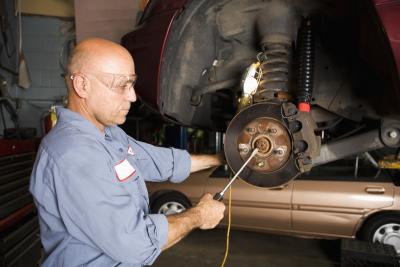
Proportioning valves meter the fluid pressure that reaches the front and rear brakes to provide vehicle stability during braking. Proportioning valves are important on vehicles equipped with front disc brakes and rear drum brakes. Front brake pads are always in constant contact with the rotor, and rear brake shoes are retracted away from the drum when not in use. Proportioning valves keep the front brakes from applying before braking pressure reaches the rear brake shoes.
An understanding of how a proportioning valve works begins with an understanding of how the proportioning valve is related to the master cylinder. Master cylinders have primary and secondary circuits that lead to the two brake lines attached to the master cylinder. When you press the brake pedal, equal fluid pressure is forced into the primary circuit and secondary circuits. The two brake lines lead into the proportioning valve, which meters the fluid pressure to the front and rear brakes according a ratio set by your car's manufacturer.
Since front brake pads are in constant contact with the rotor, the proportioning valve delays sending pressure to the front calipers until sufficient pressure reaches the rear brake shoes to overcome spring pressure and apply the brakes. If this process did not happen, the front brakes would immediately apply and force the car into a nose dive. On vehicles with rear disc brakes, the proportioning valve ensures fluid pressure has time to reach the rear brakes before full pressure is applied to the front brake calipers. This action is controlled by metering valves within the proportioning valve.
After the proportioning valve has applied the correct initial pressure to the front and rear brakes, the valve allows the driver to apply full pressure to front and rear brakes at the correct ratio for safe stopping. If more pressure reaches the rear brakes than the front brakes, the driver will experience rear brake lockup and a loss of directional control. If too much pressure reaches the front brakes, the car will nose dive, increasing the potential for harm to the vehicle's passengers. Even braking increases the ability to stop and control the vehicle in an emergency.
A check valve within the proportioning valve maintains a 10 psi residual pressure. The 10 psi residual pressure is applied to the rear brakes to provide drivers with a firmer brake pedal during sustained braking. If you are experiencing brake fade during sustained braking, the check valve within the proportioning valve may be defective. On some vehicles, if the pressure within the proportioning valve falls below a predetermined level, a warning light will illuminate on the instrument panel. This warning system is separate from the warning system on the master cylinder.